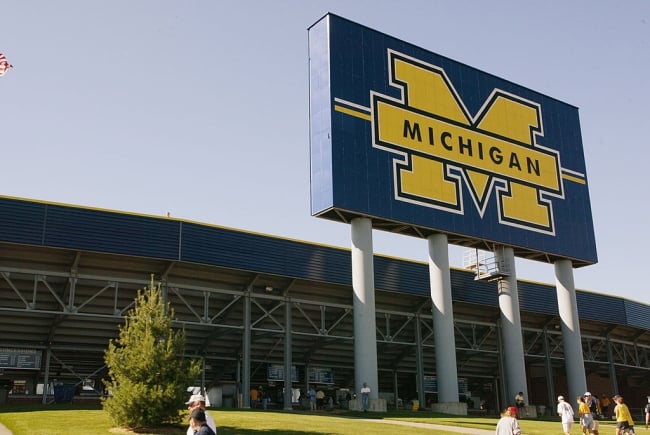You have /5 articles left.
Sign up for a free account or log in.

Danny Moloshok/Getty Images
When the University of Michigan made its decision to reopen campus for the fall, things were looking good. The administration released a plan in June, when case counts were low and hospital beds open. In the time since that announcement, university leadership has been the subject of serious distrust, concern and speculation by faculty, staff and students.
With the Faculty Senate currently considering a vote of no confidence in the administration and the graduate employees union considering a strike-authorization vote, there is now significant frustration among employees. Top of mind for several staff members is what they see as a severe lack of transparency from the administration.
“It’s just a pattern of a kind of theater of consultation,” said Silke-Maria Weineck, a professor of comparative literature and German studies at the University of Michigan at Ann Arbor.
Haley Johnson, a sophomore at the Ann Arbor campus and a member of the One University campaign for equitable funding for the Flint and Dearborn campuses, said the pressure is now coming at the administration from all angles.
“We keep getting emails that say nothing,” she said. “The entire priority is looking good, making it seem like things are back to normal without providing what students and faculty and staff need to feel safe on campus.”
Public relations experts have continuously stressed that the key for any administration to maintain trust during a reopening is to be communicative and transparent about a plan and the foundation it’s based on. Some staff say the university has taken the opposite approach.
Kirsten Herold, a lecturer in the School of Public Health and vice president of the lecturers’ union, said the reopening plan was “top-down.”
“Their basic attitude has been ‘Trust us, we know what we’re doing,’” she said.
Michael Atzmon, a professor of nuclear engineering, said the administration has turned a blind eye to the changing public health conditions in the United States.
“We see a pattern of contempt for common sense, for the intelligence of community members and their lives,” Atzmon said. “The decision on hybrid teaching, made many weeks ago, has become indefensible.”
This level of distrust wasn’t built up all at once, but through a series of events over time.
Some of the controversy has concerned the president’s decision-making committees. The president’s office formed several committees to focus on different aspects of reopening, such as ethics, lab classes and public health, and to take their recommendations to leadership. Most members of those committees were deans, administrators or associated with the medical or public health schools.
When the administration approached the lecturers’ union hoping to make a deal that could result in freezing wages, the organization proposed including lecturers on some of those committees, Herold said. The raises were worth about $3 million, but the union was rebuffed.
“They had no interest in that,” Herold said.
In June, one of those committees -- the Ethics and Privacy Committee -- published a report that the administration made public. That report outlined a conceptual framework for ethical considerations in reopening.
But in late July, a memo to the president from members of that same committee circulated privately through campus.
“Our main point here is not to advocate for a specific solution,” the committee members wrote in the memo to the university president, “but rather to underscore, with urgency, our concern that current plans for Fall 2020 will not meet the reasonable standard for safety recommended by our report, that good alternatives exist, and that it is not too late to pursue them.”
The letter did not receive a public response from the president and was not made public. That was a red flag for some faculty.
“These are people you asked, ‘How can I do this ethically? How can the university proceed ethically?’ And this committee then tells you, ‘This ain’t it,’ I think that’s worth a correction of course,” said Weineck. “What does it mean that such a dire warning goes unheeded and unpublicized?”
Then in August, 830 university employees signed an open letter asking the administration to release the models used to determine the level of risk associated with the reopening plan.
“Without such an analysis, we can have no confidence that our reopening plan will not put these communities at risk,” the letter said. “We have come to expect our institution to lead the way in science-informed policy. But here, on this most urgent question of public health, the science that guides the plan is not to be seen.”
Major public universities have often not been forthcoming with the statistical modeling they are using to make decisions -- if they are using any at all. Earlier this summer Inside Higher Ed requested the COVID-19 modeling used in decision making from 18 institutions across the country. So far, only one has provided such documents.
Michigan administrators also did not release a statistical model or analysis of risk to the community.
“The university’s plans are informed by the latest safety measures recommended by the Centers for Disease Control and Prevention, the state of Michigan and the guidance of U-M experts from public health, education, medicine, engineering and others across our campus community,” President Mark Schlissel wrote in a private response to the signatories of the open letter. “We recognize that these are complex issues about which thoughtful people will disagree.”
Dante Amidei, the author of the letter, said the administration has subjected the community to an unknown risk.
“The university has still not shown us an analysis with any kinds of outcome metrics about the level of risk to the community. They’ve acted in a high-handed way,” he said. “They’re saying, ‘Trust us,’ and I think that is just unacceptable for a public institution.”
Michigan administrators say they have been transparent and taken feedback. Though they offered no public response to the leaked memo from the Ethics Committee, university leaders noted that,among other measures, density in residence halls was reduced to 68 percent and 78 percent of undergraduate courses were moved online, which addressed some of the concerns highlighted in the memo.
“The university has shared publicly its plans for the fall semester, which are based in part on the work of more than a dozen different committees composed of faculty and staff on the Ann Arbor campus,” a spokesperson for the college said via email. “University leaders have sought and followed the advice of experts across the campus, the community, the state and nationally. These experts include faculty from our School of Public Health, our Medical School, our School of Education, physicians from Michigan Medicine (our health system), as well as faculty experts and leaders in many other areas.”
Some of the back-and-forth between faculty and the administration can potentially be traced back to unclear and sometimes contradictory guidance from public health officials and scientists. The August open letter also criticized the university’s testing regimen, which has entailed testing students in residence halls upon arrival and testing a random sample of 3,000 volunteers weekly. This regimen is not as intensive as some institutions', which are using universal surveillance testing.
“At this time, there is nothing from public health guidance that suggests we should be conducting widespread testing of asymptomatic individuals. Focusing on asymptomatic testing draws resources away from symptomatic testing, quarantine, contact tracing, and behavior modification,” the university wrote on its FAQ page and in response to the letter.
Some faculty have questioned the accuracy of that statement. At least one study has suggested all students should be tested every two days. But conversely, the Centers for Disease Control and Prevention have not recommended mass asymptomatic testing.
The anger and distrust with the administration at Michigan has in some cases turned to rumor or speculation.
An op-ed in the student newspaper from an anonymous staff member suggested that Ron Weiser, a member of the Board of Regents, was improperly influencing the university’s decision making around reopening.
“When the decision was made to reopen, U-M’s Board of Regents was chaired by one of Ann Arbor’s largest landlords, Ron Weiser -- a billionaire Trump megadonor who has given more than $100M to U-M in the last six years. He closed a new $30M gift within days of U-M’s decision to reopen,” the author wrote. “In one of the biggest conflicts of interest imaginable between public health and private wealth, Weiser’s company McKinley, which he founded and of which he is majority owner, stands to take a financial hit if students didn’t come back and pay rent.”
Those accusations have been taken seriously by some. A “die-in” protest on Monday organized by the graduate employees' union coupled its criticism of Schlissel with speculation about Weiser. One sign present at the protest read, “Regent Ron Weiser Wants Your Rent, and Your Life.”
Weiser and the university administration have said none of the speculation is true. The Board of Regents did not hold a vote on whether to reopen campus, and the gift agreement for Weiser’s $30 million donation -- to create a diabetes research center -- was signed before the summer. Weiser told Inside Higher Ed that he and the CEO of McKinley estimate that only 2 percent of their tenants in Ann Arbor are students of the university, and very few of those are undergraduate students. Weiser denied he would take a financial hit if students didn’t return.
“It’s completely inaccurate,” Weiser said. “I had no influence on what that decision was.”
For her part, Herold, the lecturer in the School of Public Health, said the lack of transparency isn’t new but that the pandemic has exacerbated the problem.
“People really feel like they're putting their lives on the line to go to work," she said. "We all hope they get it right.”








